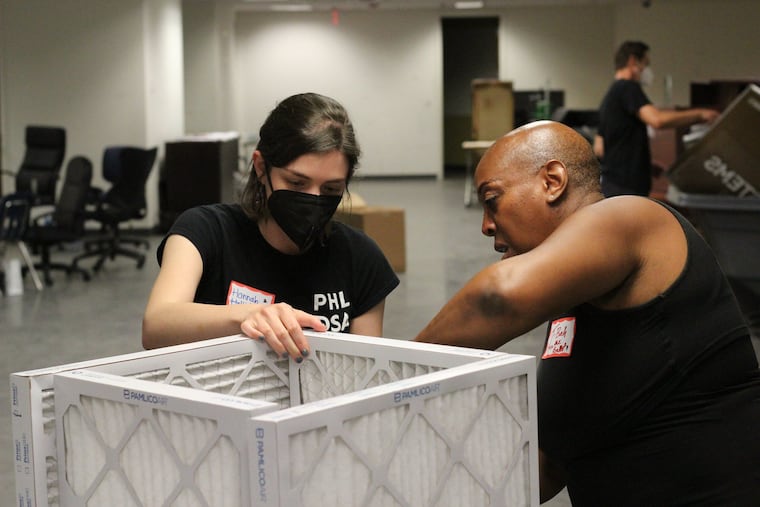Philly schools need air-conditioning. But ventilation is also lacking. These groups want a change.
The Safe Air for Philly Schools campaign has asked the district to install HEPA filtration devices in all Philadelphia School District-occupied spaces.

A group of parents, teachers, elected officials, public health experts and community members believes the Philadelphia School District must act urgently to improve the air that students and staff in city schools breathe.
“We are deeply concerned that the majority of Philly public schools do not have sufficient ventilation and air filtration, and many schools still lack air-conditioning,” said a letter recently sent to the city school board and signed by 39 individuals and organizations.
“The lack of safe air in many schools leads to higher rates of respiratory virus transmission, asthma attacks, and other serious health problems. Philadelphia’s childhood asthma rate is double the national average, and poor air quality contributes to high rates of school absence and missed instruction.”
The group is asking the district to commit to installing HEPA filtration devices in all Philadelphia School District-occupied spaces; it estimates it would cost the school system about $2 million to purchase such devices across the district’s 216 schools.
Philly’s large-scale facilities issues
Philadelphia’s school facility issues are enormous; the average district school is more than 70 years old, and officials have estimated $7 billion in unmet capital needs. Some district schools have no mechanical ventilation at all.
At the height of the pandemic, the district spent $4.5 million on air purifiers that some health experts have said are ineffective at best and harmful at worst — holding the potential to create harmful chemicals. Those air purifiers remain in schools, and the board last year authorized $2.5 million to buy replacement parts.
Bryan Cummings, a Philadelphia air-quality scientist, noted the ionizing air purifiers the district uses were problematic and said HEPA filters remove from the air not just pathogens such as viruses, but also other types of pollution, like car exhaust, pollen, and more.
“Filtration-based air cleaners are not just a strategy for better health, but they can play an important and cost-effective role in our district achieving its goals relating to learning outcomes,” Cummings said in a statement.
Philadelphia teacher Charlie Hudgins teaches math at Lincoln High in the Northeast. Lincoln was constructed in 2009, so it doesn’t have the ventilation issues many other schools have.
But Hudgins, who led his robotics team in building Corsi-Rosenthal boxes, DIY air purifiers that Philadelphia Democratic Socialists of America — the group behind this “Safe Air for Philly Schools” campaign — has placed in some district buildings, said there are schools in which he wouldn’t teach because of ventilation and air-quality issues.
“I want to know if I go somewhere else in the district, I don’t have to weigh changing work locations against the possible hazard to my health,” said Hudgins. “Those are the kind of calculations one does working in this district. If you knew there was modern HVAC in these buildings, it would make it easier to choose a work site.”
Superintendent Tony B. Watlington Sr. has emphasized boosting student and teacher attendance as a central tenet of his strategic plan for improving academics in the district.
“If you care about that, then you care about air filtration,” said Hudgins.
‘We need a plan’
At Houston Elementary in Mount Airy — a school that has no air-conditioning nor operational ventilation system — students in the science club recently made their own Corsi-Rosenthal boxes to help improve air quality. The kids enjoyed the activity, said Emily Pugliese, parent of two students at Houston.
“But it shouldn’t be on the labor of our kids, the donations of volunteers to make sure that the air quality in our schools is safe. That should be something the district is taking care of,” said Pugliese. “We understand that this has been left to the current administration, this is decades of underfunding, but we need a plan for putting in ventilation systems, for putting in air-conditioning in the schools that don’t have it.”
The U.S. Centers for Disease Control in 2023 issued recommendations for ventilation and air filtration inside buildings, calling for “five or more air changes per hour of clean air to help reduce the number of germs in the air.” Some of the district’s current ionizing air purifiers provide no air changes; others provide less than one per hour.
“There is no time to waste,” the group wrote. “Tens of thousands of students’ and workers’ health is at stake. After years of delays, we are asking the school district not to wait for a comprehensive facilities plan to tell every parent and staff member when they can expect safe air in their school.”